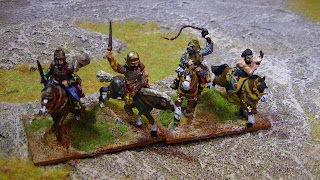The Kushan, Kushan, Kushan, Kushan or Kusana are Indo-European, a fraction of the Yue Shi, which created an empire centered around Pakistan, Afghanistan and northern India. It prospered between the 1st century and the 3rd century of the Christian era.
The name of Kushan is derived from the Chinese Guishuang, which described one of the five tribes of the Yue Shi, an unstructured confederation of Indo-European peoples, who probably spoke versions of the Tokharian language
The name of Kushan is derived from the Chinese Guishuang, which described one of the five tribes of the Yue Shi, an unstructured confederation of Indo-European peoples, who probably spoke versions of the Tokharian language
The most famous Kushan ruler was Kanishka I, who reigned from about AD 127 to 150 and promoted the expansion of Buddhism and, consequently, Greco-Buddhist art. The Taliban destroyed its statue, a unique piece of the Kabul Museum in Afghanistan in 2000.
Quote from Gérard Fussman:
"Kanishka is the sovereign we know best, and the Indian Buddhist sources, transmitted by Chinese or Tibetan translations, have preserved their memory and made him a protector of Buddhism, not exclusively. Bactrian inscriptions in the Greek alphabet from the great dynastic sanctuaries of Surkh Kotal and Rabatak - both located in northern Afghanistan - give us an idea of his beliefs, his family and his activity, and he presents himself as a divine race , Invested with royalty by the goddess Nana and the gods of Mazdean Iran.
Quote from Gérard Fussman:
"Kanishka is the sovereign we know best, and the Indian Buddhist sources, transmitted by Chinese or Tibetan translations, have preserved their memory and made him a protector of Buddhism, not exclusively. Bactrian inscriptions in the Greek alphabet from the great dynastic sanctuaries of Surkh Kotal and Rabatak - both located in northern Afghanistan - give us an idea of his beliefs, his family and his activity, and he presents himself as a divine race , Invested with royalty by the goddess Nana and the gods of Mazdean Iran.
In the year I of his accession he instituted a new era and ordered to replace the Greek by the Bactrian in the official documents. Protectors of the dynasty and his ancestors, he erected at the top of hills a series of gigantic temples: Surkh Kotal in Afghanistan and Māt in India, near Mathurā, are two examples And there must have been many more.
The Rabatak inscription confirms what the analysis of monetary findings indicated: the Kanishka Empire extended over Tajikistan, Uzbekistan, the eastern part of Afghanistan, Pakistan, all of North India up to In Bengal and the Narmada. It is not known where his capital was. It seems that there was none: the capital followed the king in his displacements. But it is clear that Bactria, now largely Afghan, played an important role. The dynasty originated there. She talked about it and spread the language. It covered it with gigantic buildings and adopted as an official art an iranized variant of Greek art (...).
(...) Kanishka reigned from 98 to 101-or, if other chronologies were chosen, from 148 to 151. It seems that one does not possess the money of his son Vajheshka (102-106) Use of its name in dating formulas. On the other hand the mints in the name of Huvishka (106-138) and Vāsudeva (142-176) are abundant. It is possible, in fact, that there were two Huvishka and several Vāsudeva, and a Kanishka II had to be placed around 119 AD during the reign of Huvishka: there are suspicions of coups d'etat or civil wars, Does not subsist. The Kushan power crumbles under Vāsudeva, which loses control of gangetic and central India. The hundreds of thousands of bronze coins struck in his name are mostly local or posthumous strikes. As early as 226 according to A.D.H. Bivar, about 368 for R. Göbl, the Sassanids of Iran make the last kushan sovereigns their vassals. But very late, sometimes until the arrival of the Muslims, in the high valleys overlooking the Indian plains - Kabul, Swat, Kashmir, Gilgit, Himachal Pradesh region - wrenches will continue to adorn themselves with the kushan title of shahi, As a nomad costume the nomadic outfit and even to strike rare golden coins extending the imperial coinage."
The figurines that I use to represent my Kouchanes elephants are Vendel miniature resin figurines (big 28mm). These pachyderms were attributed to Scythian horsemen as a crew. The army has an elephant in DBA version and three elephants in DBA big battle version.
The Kushan infantry consists of Indian combatants in difficult terrain. These troops are characterized by the wearing of colored turbans. The boudhic pattern of the wheel decorates a large number of shields.
The Kushan army originally included many Scythian light horsemen (the Yue zhi, the founders of the Kushan dynasty, being themselves a component of the Scythian people). The 12 light horsemen's plates of my Scythian army are all Naturally aligned when I play my Kouchanes. The figurines are posted in the article "Royal Scythes" but I also place them here for more readability.





























